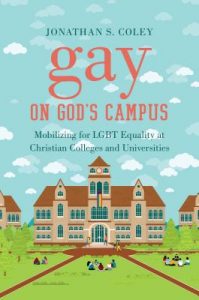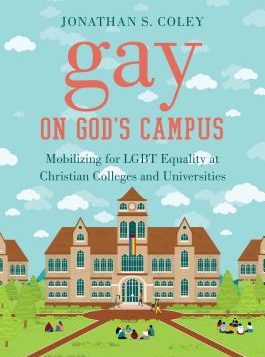 Gay on God’s Campus: Mobilizing for LGBT Equality at Christian Colleges and Universities
Gay on God’s Campus: Mobilizing for LGBT Equality at Christian Colleges and Universities
by Jonathan S. Coley
University of North Carolina Press. 194 pages, $27.95
AT FIRST GLANCE, a title like “Gay on God’s Campus” suggests the depressing old tale of gay people’s suffocation in Bible-fog. In fact, nothing about this book is depressing, and it serves as something of a light in the fog, focused as it is on how gay students and their supporters have succeeded in moving their colleges into, if not exactly the 21st century, at least a reasonably modern way of treating LGBT students. In some cases the students generated significant change in college policy, resulting in genuine nondiscrimination policies, at least on paper. In other cases student-led groups were able to establish support groups on campuses with long traditions of antipathy toward anything that looked gay.
The author, Jonathan S. Coley, is a professor of sociology at Monmouth College, and this book is built around a case study of gay activism at four colleges: Belmont University (loosely Baptist), Goshen College (Mennonite), Catholic University of America, and Loyola University-Chicago (Catholic). The author conducted extensive interviews, mainly with students, and also used surveys on a number of subjects to generate a multilayered view of how students really interact with these institutions and with each other.
The chapters are organized around the surveys rather than the institutions, which means that in some cases you read about a given situation, school, person or policy from two or three angles. The author sets out to answer three questions: 1) Why do students participate in LGBT activism at Christian colleges and universities? 2) Why do students commit to LGBT activism at Christian colleges and universities? 3) How do LGBT activist groups at Christian colleges and universities impact their participants?
He responds to these questions by concluding that “there are multiple pathways to activism, patterns of commitment to activist groups, and biographical consequences of activism.” Activists (mostly gay, some straight) are sorted into three categories of students: those with an “activist identity” (the more politicized students); those with a “value-based identity” (having a strong religious identity); and those with a “solidarity identity” (interested mainly in a support situation). These three identities are very helpful in understanding why the flow of change at particular colleges went the way it did.
The author notes in passing some previous writing on the issue of being a gay Christian, such as Matthew Vines’ God and the Gay Christian (2013), but others are not referenced. This is not, after all, a history of gay activism at religious colleges. The book is quite focused on his four study schools and their students, which limits its broad utility somewhat. The author makes use of the monster database that he has compiled of college policies across the U.S.
One distinctive aspect of this study is that Coley conducted some interviews with straight students involved in gay rights activities. For example, Kylie at Goshen College was a straight woman who was raised in a very pro-gay household and had written a high school paper supportive of gay marriage. She had always been active in gay-supportive activities (in part because she had a gay friend) and merged right into the support group at Goshen. Several other interviews with straight students are included, but most are with gay students. Their stories are familiar in a broad sense, but each individual has a unique story to tell in its particulars.
The importance of students’ religious faith might seem obvious in a study of this nature, but the author does ask his subjects to explain why they chose a religious institution and how their sexual identity figured in this decision, as well as how experiences as a gay person continue to interact with their faith. For example, Eric, a student with strong family connections to the Catholic Church, states: “I generally considered myself, and still do consider myself, to be socially conservative, I’m very pro-life. … I was raised to believe homosexuality was a sin. And this is the one issue where I now have a little thing, a small disagreement with the church—but it’s the kind of thing where I’m not going to throw away my entire faith over one issue.”
This profound commitment to the basics of their faith is a common theme among the student stories. The activists often used traditional religious arguments to support their requests for change. Such items as the by now traditional “What Would Jesus Do?” signs and the insouciant “Jesus Had 2 Dads and He Turned Out Just Fine” are scattered throughout the book.
Only limited information is given about the internal processes that led to progressive changes at the colleges. A set of interviews with senior college leaders and board members would have been a good addition. This material is not entirely absent: where available, Coley makes good use of public statements about these reforms. Using only four colleges was probably the only practical way for one person to conduct such an interview-based project. It would have been useful to have had similar data from, say, Brigham Young University, a couple of Lutheran colleges, and a wider variety of conservative Baptist schools.
________________________________________________________
Alan Contreras is a writer and education consultant based in Eugene, OR.






